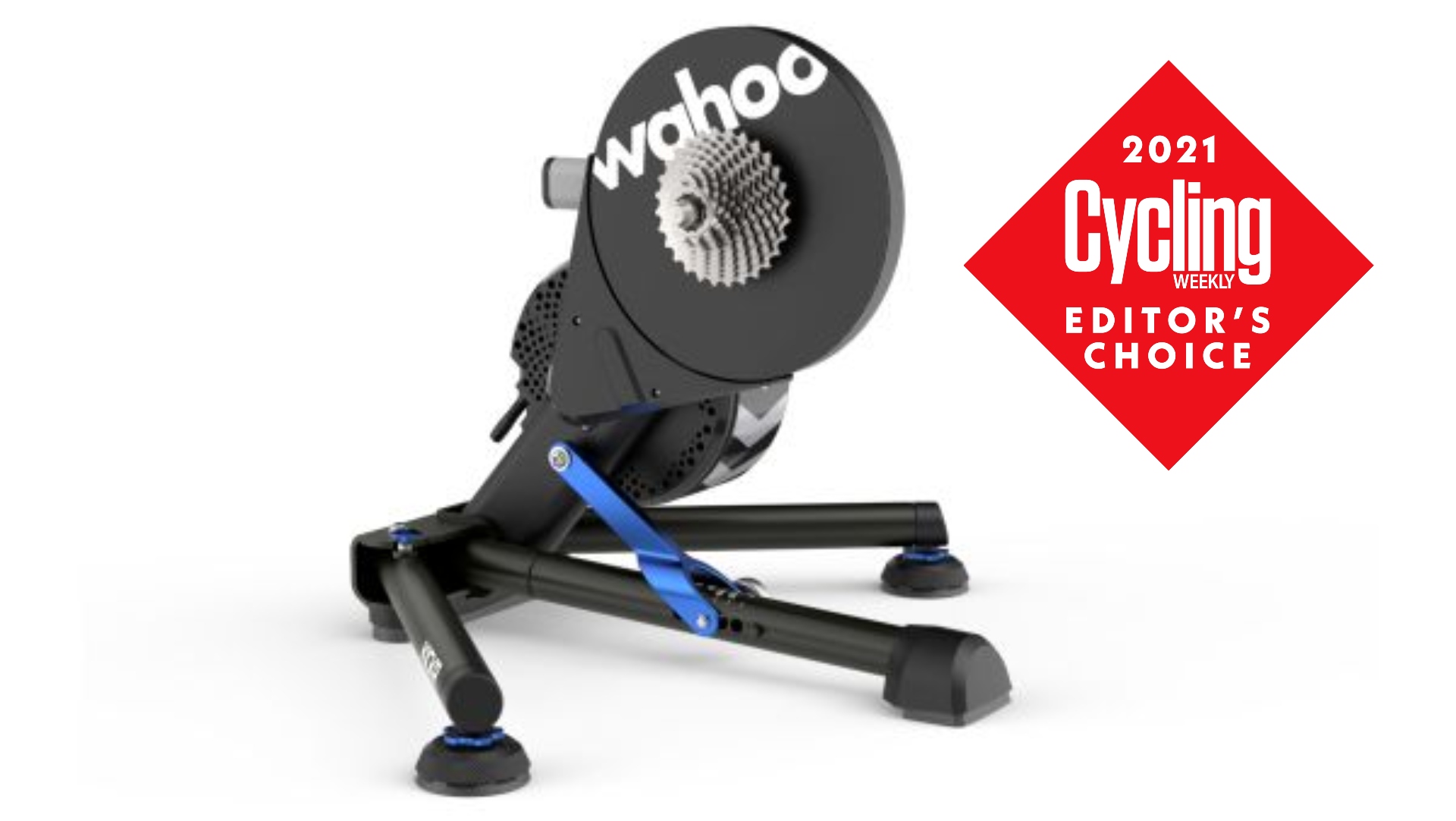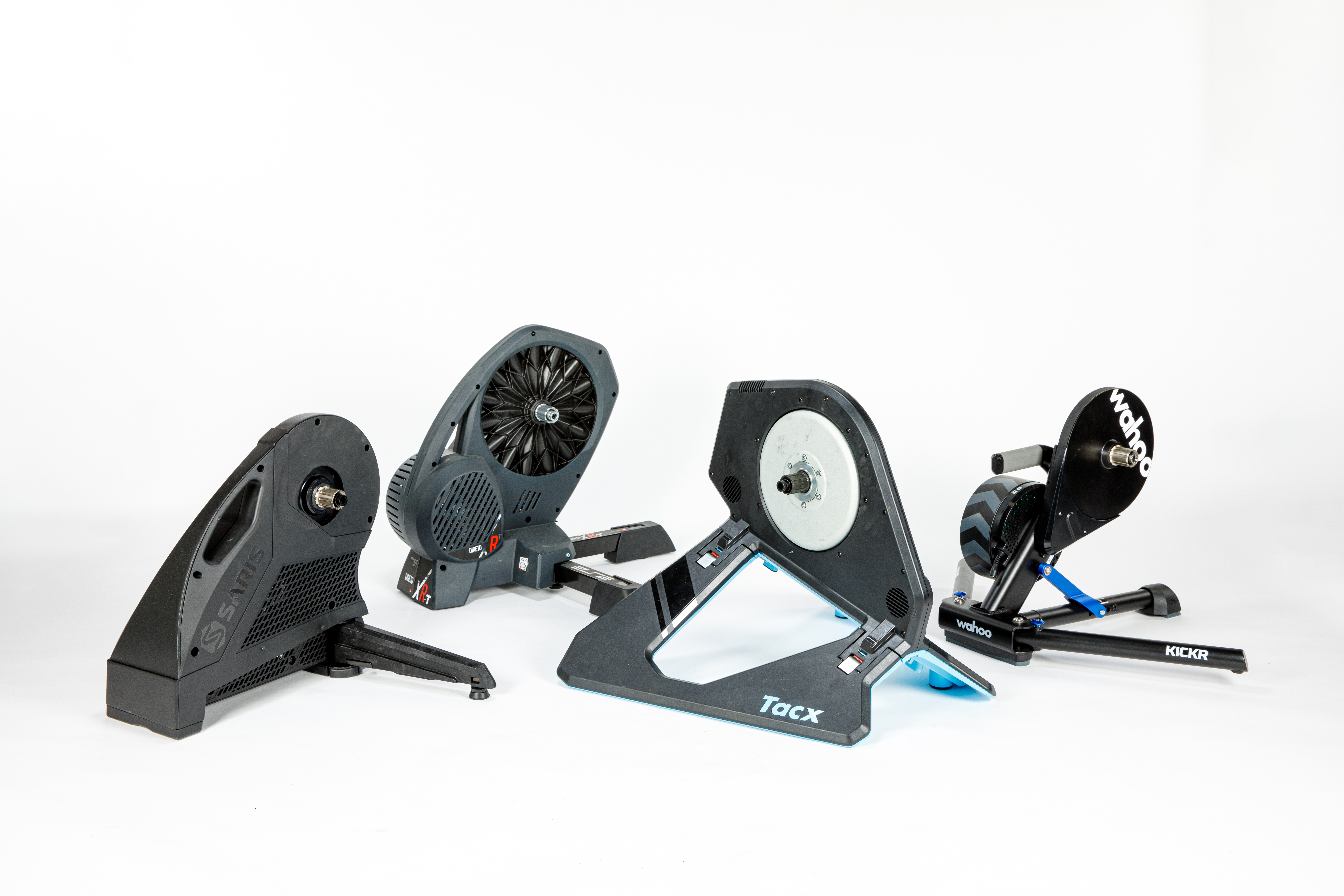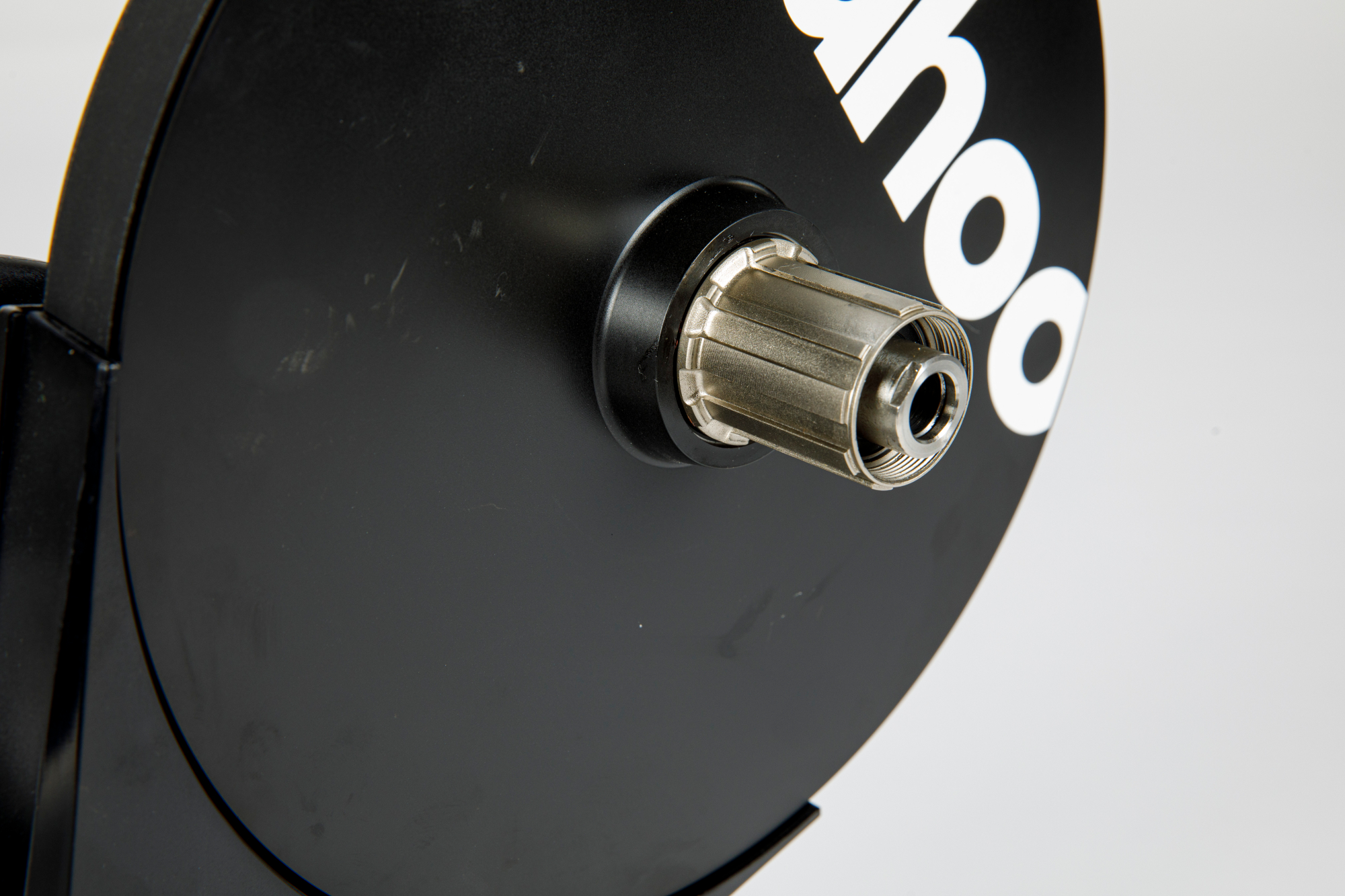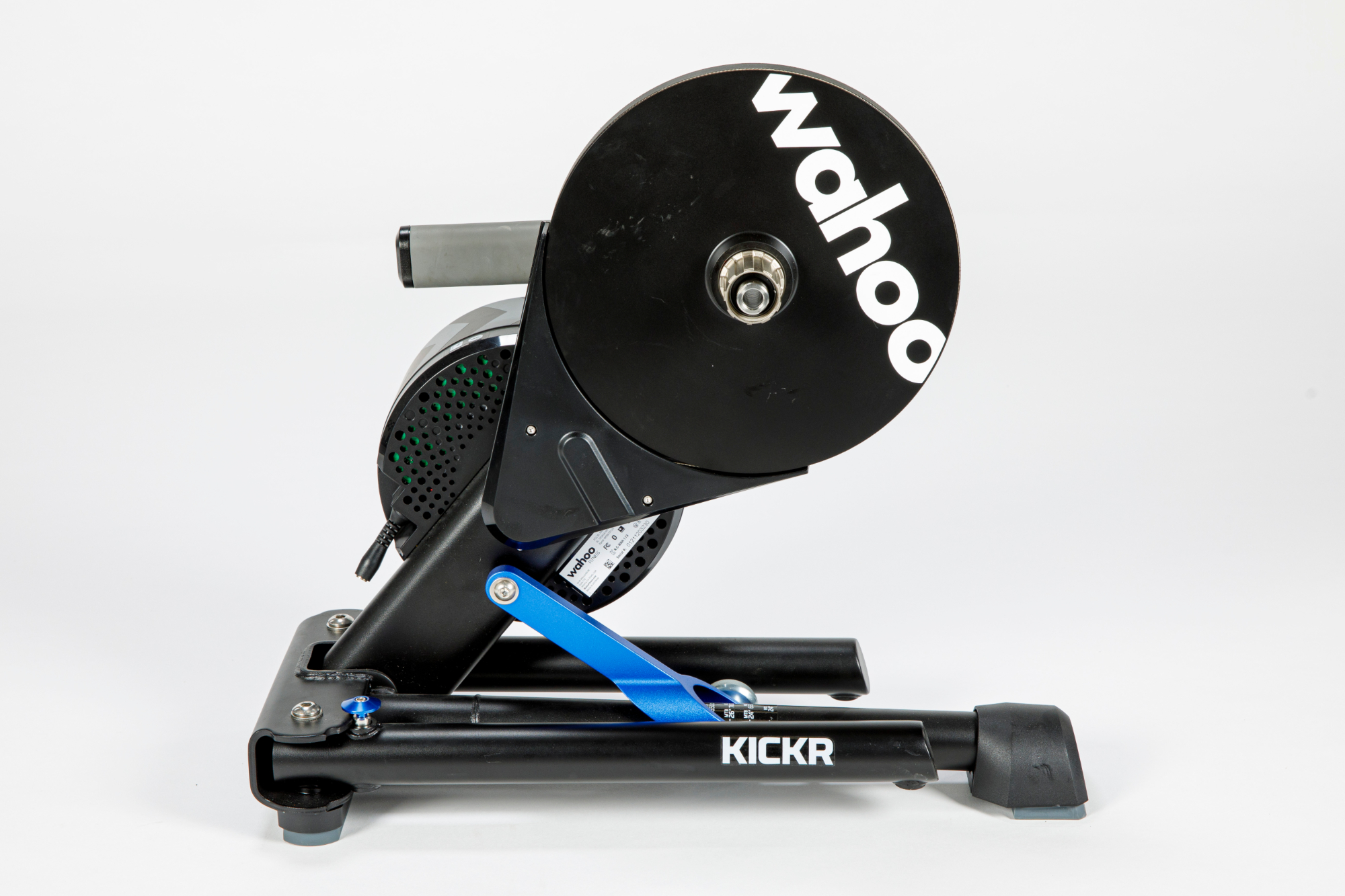Wahoo Kickr V5 review
A great smart trainer for Zwift racing and general training

With a smooth feeling erg mode, a compact packaway size, and in not needing to be manually calibrated, the Kickr ticks more boxes than any of the other trainers on test. It’s also not outrageously expensive – at least comparative to other top-of-the-range direct-drive turbos.
-
+
No need to zero offset
-
+
Smooth feeling erg mode
-
-
Relatively expensive
-
-
Short middle leg reduces fore/aft stability when sprinting
You can trust Cycling Weekly.

The Wahoo Kickr has been around for a while now, with updates to the smart trainer generally being more incremental than transformative. But considering the performance of each edition, that’s no bad thing.
For the V5, Wahoo has added feet to reduce vibrations from the trainer and to add a little sway, as well as increasing the claimed accuracy from ±2 per cent to ±1 per cent and removing the requirement to manually calibrate the trainer.
We tested the Wahoo Kickr V5 as part of a four-up comparison grouptest to find the best smart turbo trainer, the Wahoo Kickr V5 went up alongside the Elite Direto XR-T, the Saris H3 and Tacx Neo 2T.

The specs
The three metrics brands tend to shout about most are the maximum resistance (2,200w for the Kickr), the power accuracy (±1%) and the maximum gradient that can be simulated (20%)
The 2,200w puts the Wahoo around the mid range for a turbo of this price point. But it is worth noting that turbo technology has really sailed past the point where this should direct your buying choice. Most people are doing very well to break 1,000w. Even touching 2,000w is something the very best track sprinters hit, rather than just mere mortals.
A 20% maximum gradient is on the low side compared to some of the Kickr's competitors, with trainers like the Tacx Neo 2T able to simulate gradients as as high as 25%.

But if the gradients your climbing come mostly from Zwift, the steepest section on the platform tops out at 22% – and that's just for a second on the second climb of the Cobbled Climbs Reverse course in the Richmond world.
The ±1% accuracy is a nice badge of reassurance, but as always with power meters, there is always some variation from unit to unit. We've had power meters which both claim 1% which when compared against each other, fall outside of each other's ranges. Top level Zwift racing requires ±2% or better, everything within that range is of a muchness – verifying your particular unit is more important.
What really differentiates trainers is the ride feel for sprinting and long efforts, as well as the erg mode's functionality and any particular design features and flaws.
Compatibility and setup
Using different end caps, the Wahoo Kickr is compatible with 130mm and 135mm Quick Release, as well as 12x142 and 12x148mm thru axles. This should cover old and new road bikes, modern disc brake gravel and road bikes and even modern mountain bikes.
Older thru axles designs such as 10x135mm and 12x135, along with the latest breed of 'super boost' MTB thru axles at 12x157mm, on the other hand, aren't supported. But good news if you're running cassettes requiring Campagnolo or SRAM XD/XDR freehub bodies, these can be bought separately.

The trainer arrives in its folded up state and with an 11-speed cassette supplied, so set up is as easy as unfolding the legs, setting the axle height to your bike's requirement and away you go – providing you do have an 11-speed bike.
The Kickr forms a pretty compact shape when folded away and, thanks to the horizontally oriented carry handle, it's quite easy to transport for its 22kg weight.
The ride
In use, the Kickr does feel more stable than the Tacx Neo 2T for hard efforts but less so than the Saris H3 – about on par with the Elite Direto XR-T. Although the central leg of the Kickr appears quite long, the amount it extends past the rear axle of the bike is actually quite short. This allows the turbo to rock fore and aft quite a bit when putting in an all-out effort, shuffling you closer to the monitor.
In terms of the resistance for sprinting, there is a bit more of a flywheel spin up than on the Saris H3 and the Elite Direto XR-T – but not weight on the same road mimicking level as the Tacx Neo 2T. It’s a halfway house that works pretty well for both ends and doesn’t result in an annoying number of shifts.
The erg mode feels very refined, just like the Tacx, with a satisfying feeling of souplesse and a proportionate responsiveness to changes in cadence – it didn't overcompensate with resistance increases when I dropped by just a few RPM.
The Kickr would take a little longer over increasing the resistance compared to other range topping turbo trainers, so when doing a 30s on / 30s easy session, the average watts for the intervals ended up being a little lower than what was set.
But this is preferable to the resistance slamming on like a wall, and you can increase your sets by a few seconds to compensate.
For added realism, you can also pair the trainer with the Kickr Climb to have the bike rise and fall on the virtual gradients. Also, for Zwift racing, the Kickr was by far the fastest to read zero watts once having stopped pedaling, boosting your ability to snatch some rest on the descents.
Power analysis
For this, I triple recorded my power numbers coming from the trainer itself, a Shimano Dura-Ace power crankset and a set of Garmin Vector 3 pedals (the updated version with solved the early accuracy issues).
To be clear, this is not a scientific test of the Kickr's power numbers – for that you'd need specialist equipment and a representative sample size, rather than just one single turbo.
But, nevertheless, it is still interesting to see how the numbers line up with those from other power meters, so let's jump in.
For the first test, I set the trainer to 250w on erg mode and rode for 10 minutes, with the result being as follows:
| Wahoo Kickr V5 turbo trainer | 249w |
| Shimano Dura-Ace power cranks | 245w |
| Garmin Vector 3 power pedals | 239w |
Across the other 10 minutes tests with the Tacx Neo 2T, Saris H3 and the Elite Direto XR-T, the Garmin pedals and the Shimano cranks lined up much more closely than they did in this effort.
But even so, the Wahoo Kickr did the second highest power numbers – relative to the cranks and pedals – for this duration out of the four trainers we had on test. Only the Saris H3 was more generous.
Next up was a set of five efforts, 30 seconds at 400w followed by 30 seconds easy spinning at 100w. This was also done on erg mode, providing a feel for how the turbo copes with sudden swings in the resistance.
| Row 0 - Cell 0 | Effort 1 | Effort 2 | Effort 3 | Effort 4 | Effort 5 |
| Wahoo Kickr V5 turbo trainer | 400w | 389w | 399w | 400w | 399w |
| Shimano Dura-Ace power cranks | 379w | 372w | 371w | 383w | 385w |
| Garmin Vector 3 power pedals | 366w | 360w | 360w | 372w | 370w |
A quick glance and you might assume the Wahoo is massively overreading the power numbers, but those averages over 30 seconds only tell half the story.
Digging into the data, it transpired that when the effort begins and the resistance is supposed to be 400w, the Wahoo Kickr will immediately start reading that value. The actual resistance of the trainer, on the other hand, takes a handful of seconds to ramp up.
Once the actual resistance has caught up with what the turbo thinks the resistance is, the numbers from the three power meters all track each other quite closely – although the average power ends up quite different.
Of course, it would be preferable if the Kickr gave the power readings of the resistance that is actually being put out, rather than the resistance the unit is set to. But at least the numbers don't actually deviate from the other power meters by as much as 10%.
The next test was a couple of 5 second all-out sprints.
| Row 0 - Cell 0 | 1 sec | 5 sec |
| Wahoo Kickr V5 turbo trainer | 1,104w | 1,020w |
| Shimano Dura-Ace power cranks | 1,063w | 981w |
| Garmin Vector 3 power pedals | 1,295w | 953w |
From this, it was evident that the issues with lag were confined to the erg mode – the power numbers from all three units tracked each other quite closely for the duration of the effort.
For the 1 second peak, the Garmin pedals did spike notably high – I'd ignore that value – but over the 5-second duration, the numbers did settle down and start to align more closely.
Value
At $1,199.99 / £999.9, the Wahoo Kickr undercuts the Tacx Neo 2T ($1,399.99 / £1,199.00) but is more expensive that the Saris H3 ($1,099.99 / £899.99).
The Tacx does offer a more realistic feel, with the surface simulation, inbuilt rocker, and a resistance curve which very accurately mimics riding outdoors – and those qualities will be convincing for some people. But we feel that for the most part, the benefits of those features don't justify in the extra spend.
On the other hand, although the Saris H3 is a solid unit that's great for hard efforts. But the need to manually calibrate / zero-offset the unit, a slight power blip when freewheeling, and a body design which doesn't play nicely with thru-axles, do all add up and make it worth while spending a little more to get the Kickr which doesn't have those issues.
Verdict
If it wasn’t for the fore/aft stability issue when sprinting, the Kickr would get a full five stars for its excellent erg mode and its great functionality for virtual riding and racing. The price, although high, isn’t out of line either.

Thank you for reading 20 articles this month* Join now for unlimited access
Enjoy your first month for just £1 / $1 / €1
*Read 5 free articles per month without a subscription

Join now for unlimited access
Try first month for just £1 / $1 / €1
Get The Leadout Newsletter
The latest race content, interviews, features, reviews and expert buying guides, direct to your inbox!

After winning the 2019 National Single-Speed Cross-Country Mountain Biking Championships and claiming the plushie unicorn (true story), Stefan swapped the flat-bars for drop-bars and has never looked back.
Since then, he’s earnt his 2ⁿᵈ cat racing licence in his first season racing as a third, completed the South Downs Double in under 20 hours and Everested in under 12.
But his favourite rides are multiday bikepacking trips, with all the huge amount of cycling tech and long days spent exploring new roads and trails - as well as histories and cultures. Most recently, he’s spent two weeks riding from Budapest into the mountains of Slovakia.
Height: 177cm
Weight: 67–69kg
-
 The thing that bothers me most when I look back at old school training is that right now we’re doing something equivalently misguided
The thing that bothers me most when I look back at old school training is that right now we’re doing something equivalently misguidedOur columnist's old training diaries reveal old-school levels of lunacy
By Michael Hutchinson Published
-
 'This race is absolutely disgusting': Peloton reacts to another brutal Paris-Roubaix Femmes
'This race is absolutely disgusting': Peloton reacts to another brutal Paris-Roubaix FemmesNow in its fifth edition, Paris-Roubaix Femmes is still a tough race, even for the best bike riders in the world
By Adam Becket Published
-
 ‘It’s the biggest win of my career’ says João Almeida after crushing Itzulia Basque Country success
‘It’s the biggest win of my career’ says João Almeida after crushing Itzulia Basque Country successUAE rider wins the final stage to finish almost two minutes clear of Enric Mas on GC, with Max Schachmann in third
By Peter Cossins Published